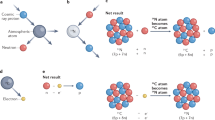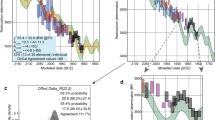Abstract
Turney et al.1 offer a useful summary of their own observations on new developments in the dating of charcoal samples. There are, however, several errors or misunderstandings in their reading of my review2.
Similar content being viewed by others
Main
I was careful to describe the NotCal04 calibration study3 explicitly as a “best-estimation” curve (as the authors3 also describe it). But, even if there were an accepted calibration curve for the period before 26,000 cal. yr BP (calibrated years before present), there are still problems with any 'authorized' calibration curve because these can soon become out of date. As I pointed out in the last sentence of my review2, the implications of such studies for the interpretation of the human archaeological and evolutionary record need to be kept under active and vigilant review.
Contrary to the assertion by Turney et al.1, I did not suggest that atmospheric 14C variability has followed a simple, smooth pattern, but noted instead that the new calibration curves (from the Cariaco Basin, Atlantic and Pacific coral samples, the Socotra island speleothem, and so on) follow a “relatively” smooth pattern, “apparently” without any of the sudden and aberrant oscillations in the atmospheric 14C content that had been claimed in some earlier studies. Important revisions4,5 have now been made to the latest calibration curves for both the Bahamas speleothem record6 and for the Cariaco Basin calibration curve7, which now show significantly smaller deviations from other calibration curves8 and render out of date the data plotted in Fig. 1 by Turney et al.1. If all these revisions4,5 in the different calibration curves were incorporated into a new best-estimation curve, this curve would now be even tighter and would conform closely to the already published NotCal04 curve. I made a point of stressing2 the potential impact of geomagnetic events, such as the Lake Mono and Laschamp excursions, for which the full impact on the terrestrial (as opposed to marine) radiocarbon records have still to be clearly elucidated.
I emphasized (Fig. 3 of ref. 2) that all radiocarbon dates (whether determined on bone or charcoal) should be regarded essentially as minimum figures, owing to the potential effects of contamination by recent, intrusive carbon. And I also made a point of presenting both the calibrated and uncalibrated versions of the dates I used. (If I had plotted dates only for charcoal samples that had been processed by newly developed methods, such as the ABOX technique, there would have been almost no dates to plot.) I did not claim to improve the precision of 'greater than' age estimates, although I noted that calibration increases the minimum age of such estimates.
The implications of regarding all of these dates as essentially minimum age estimates must be kept clearly in mind in any applications of 14C dating to modern human dispersals, as I took pains to stress2. Even so, the very marked geographical patterns visible in my Fig. 3 of the combined, best-available charcoal and bone dates should not be dismissed, even by the most pessimistic critics of the present state of radiocarbon dating in prehistory.
References
Turney, C. S. M., Roberts, R. G. & Jacobs, Z. Nature 443, 10.1038/nature05214 (2006).
Mellars, P. Nature 439, 931–935 (2006).
van der Plicht, J. et al. Radiocarbon 46, 1225–1238 (2004).
Beck, J. W. Nineteenth Int. Radiocarbon Conf. April 3–7 abstr. (Oxford, UK, 2006).
Hughen, K. Nineteenth Int. Radiocarbon Conf. April 3–7 abstr. (Oxford, UK, 2006).
Beck, J. W. et al. Science 292, 2453–2458 (2001).
Hughen, K. et al. Science 303, 202–207 (2004).
Fairbanks, R. G. et al. Quat. Sci. Rev. 24, 1781–1796 (2005).
Author information
Authors and Affiliations
Rights and permissions
About this article
Cite this article
Mellars, P. Progress and pitfalls in radiocarbon dating (Reply). Nature 443, E4 (2006). https://doi.org/10.1038/nature05215
Published:
Issue Date:
DOI: https://doi.org/10.1038/nature05215
Comments
By submitting a comment you agree to abide by our Terms and Community Guidelines. If you find something abusive or that does not comply with our terms or guidelines please flag it as inappropriate.



